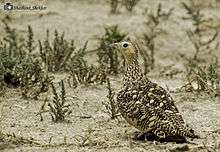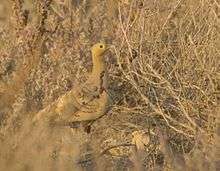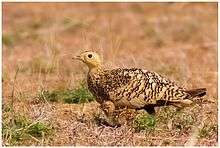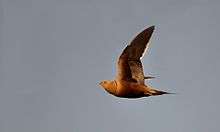Chestnut-bellied sandgrouse
| Chestnut-bellied sandgrouse | |
|---|---|
.jpg) | |
| Scientific classification | |
| Kingdom: | Animalia |
| Phylum: | Chordata |
| Class: | Aves |
| Order: | Pteroclidiformes |
| Family: | Pteroclididae |
| Genus: | Pterocles |
| Species: | P. exustus |
| Binomial name | |
| Pterocles exustus (Temminck, 1825) | |

.jpg)

The chestnut-bellied sandgrouse (Pterocles exustus) is a species of sandgrouse. They are found in sparse, bushy, arid land which is common in central and northern Africa, and southern Asia. Though they live in hot, arid climates, they are highly reliant on water. They have been known to travel up to 80 kilometres (50 mi) in one day in search of water. All species of sandgrouse that have been studied in habitat have proved to be entirely vegetarian throughout their lives, specialising in leguminous weed seeds and seldom eating grass seeds.


In the 1960s many birds were captured using clap traps from Rajasthan in India and introduced into Nevada. They have also been introduced to Hawaii.[2]
A subspecies, P. e. floweri, was last seen in the Nile Valley of Egypt in 1979. It is thought to be extinct, but the reasons for this are unknown.[3]
References
- ↑ BirdLife International (2012). "Pterocles exustus". IUCN Red List of Threatened Species. Version 2013.2. International Union for Conservation of Nature. Retrieved 26 November 2013.
- ↑ Christensen, Glen C. (1962) Use of the Clap Net for Capturing Indian Sand Grouse. The Journal of Wildlife Management. 26(4):399–402.
- ↑ Hume, J. P.; Walters, M. (2012). Extinct Birds. London: A & C Black. p. 133. ISBN 1-4081-5725-X.

